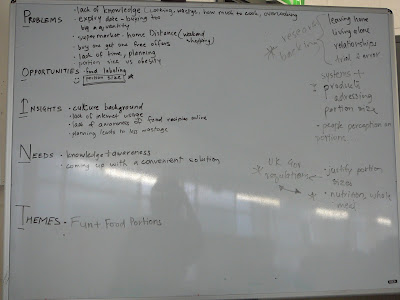 Today we met to start narrowing down our focus a little more. The issue of food waste, after all, is a big issue, and there are many ways to approach it. We were beginning to feel a little overwhelmed by all the research--it seemed like as soon as we closed off one avenue of approach, half a dozen new paths to follow would pop up. We wanted to develop a little more direction. To do that, we decided to use a POINT brainstorm.
Today we met to start narrowing down our focus a little more. The issue of food waste, after all, is a big issue, and there are many ways to approach it. We were beginning to feel a little overwhelmed by all the research--it seemed like as soon as we closed off one avenue of approach, half a dozen new paths to follow would pop up. We wanted to develop a little more direction. To do that, we decided to use a POINT brainstorm. The POINT brainstorm is a technique that Colin Burns (former head of IDEO) taught us at the beginning of the semester. Basically, you sort all of your observations into several categories:
- Problems
- Opportunities
- Insights
- Needs
- Themes
From that, we decided that portion control was the issue that we wanted to tackle. The scope was small enough for us to have real impact, we felt, and it's an issue that addresses several problems at once: food waste and healthy living! We wanted to make sure that we were addressing the issue from the perspective of fun. Whatever portion control solution we came up with, we wanted it to be whimsical and delightful, like the VW Fun Theory stuff.
After our brainstorm, we divided up a couple of tasks--Neha, Ryan, and Wendy were going to research pre-existing portion control products, while Liza and I were going to look into UK government nutrition guidelines.








